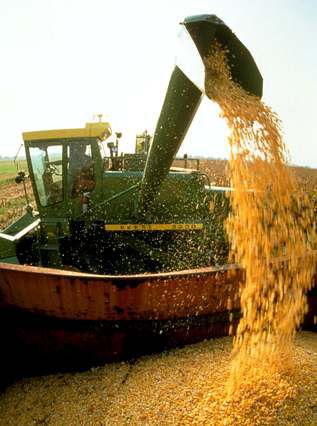Diversification May Be Key in Today’s Low-Income Ag World
Published
1/31/2017
While farm income is down across the board, today’s farm economy is noticeably different than it was in the 1980s, according to Dr. Bob Young, chief economist at the American Farm Bureau Federation.
At a workshop at AFBF’s 2017 Annual Convention & IDEAg Trade Show this month, Dr. Young and members of the AFBF economics team gave an overview of the farm economy and what the agricultural economy may look like five to ten years from now.
“We have actually brought on board almost 200 million acres in agricultural production worldwide since 1990,” Young said. “That’s almost the size of U.S. agriculture.”

The demand side of the equation has also increased substantially, said
Dr. John Newton, AFBF’s director of market intelligence, said that supply has continued to outpace demand, putting pressure on prices. The biofuel boom is over, and livestock is flat, Newton said, so international trade is taking on increasing importance in the global economy. Agricultural exports were $133 billion in 2015, with more than 50 percent of U.S. agricultural trade coming from Mexico, Canada,
“The key is to recognize the market we are now in, think about how we can make effective marketing decisions and see the marketing opportunities when they become available,” Newton said. “It’s a new paradigm. The golden age of agriculture income is over.”
Arizona Farm Bureau sought forecasts and predictions about Arizona agriculture from our own economist. “Two regular wild cards in the mix are drought and exchange
At The Farm Level
Katelyn McCullock,
“Every operation, regardless of what industry you are in, can look at genetics and technology,”
Veronica Nigh,
Nigh said it can be a good strategy to consider additional sources of income to increase revenue. Uber’s slogan is “Get your side hustle on,” which is a good way to think about new ways to add income to farm operations.
“Diversification can be an important tool to bring in income,” Nigh said. “Farm to table is a good opportunity. People like to know where their food comes from. And what about things like stocking your fishing pond, turning it into a private lake, or starting a hunting and fishing operation? We have all this space, so why not offer motor home, boat and trailer storage?”
Echoing the importance of trade, Nigh added that there are numerous resources and trade organizations that can help you market your farm products to export markets.
Outlook for U.S. Crop Prices Continues to be Below Average
In the meantime, The U.S. grain price outlook and crop demand for 2017-2018 will likely show no major changes according to Dr. Pat Westhoff, director the of food and Agricultural Policy Research Institute at the University of Missouri.
Trends for 2017 look to stay similar to that of 2016, unless a major disruption in outside factors occurs, such as weather or foreign market changes, according to Westhoff. Prices will continue to be below average, and lower than 2016, based on trends, he said.
“Lots of pressure will be placed on labor markets where there hasn’t been in the last several years,” Westhoff said. This a result of poor labor markets and a slowing rate of population growth.
“Most of the immediate population growth will occur in the age range of people who are not of working age in the U.S., adding to the stress on the labor market,” Westhoff said.
Yields for global grains and oilseeds have increased by roughly 1 percent per year since 1980; this is the same rate as the global growth in population, Westhoff said. Similarly, the area harvested for wheat, rice, corn and soybeans around the world between 2002 and 2014 increased by 17 percent; world per capita consumption is at a 16 percent yearly increase.
“China and biofuels accounted for all the growth in per capita consumption since 1980,” Westhoff said. Ethanol production and an increase in Chinese consumption per capita
Recently, biofuel growth has slowed and there are questions about the future of Chinese growth, as well. The grain and oilseed markets stand to continue current trends because of this, according to Westhoff.
“World production of the four major crops – corn, wheat, soybeans and rice – increased by nearly 50 percent since 2002,”
Former chief economist of the U.S. Senate Committee on Agriculture, Nutrition and Forestry and dairy farmer with his family in eastern Iowa, Westhoff also addressed the outlooks on global and U.S. markets for each of the major crop markets separately – corn, soybeans, wheat,
And